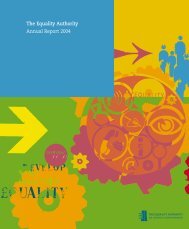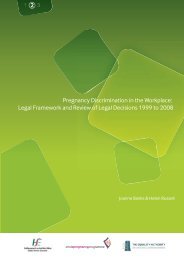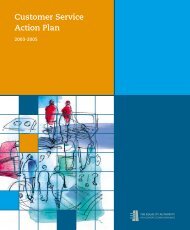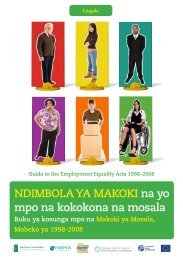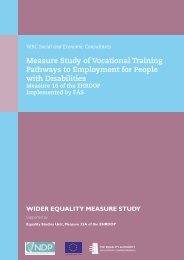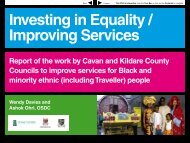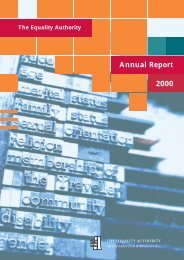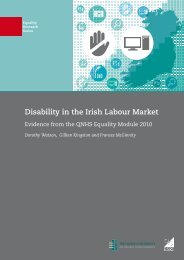Pregnancy and Employment: A Literature Review - Crisis Pregnancy ...
Pregnancy and Employment: A Literature Review - Crisis Pregnancy ...
Pregnancy and Employment: A Literature Review - Crisis Pregnancy ...
Create successful ePaper yourself
Turn your PDF publications into a flip-book with our unique Google optimized e-Paper software.
<strong>Pregnancy</strong> <strong>and</strong> <strong>Employment</strong>: A <strong>Literature</strong> <strong>Review</strong><br />
The sectoral effect could arise because public-sector employees are better protected than private-sector<br />
employees (e.g. given better leave packages) or may be related to the greater availability of family-friendly work<br />
arrangements in the public sector. This latter proposition is tested directly in a number of recent British studies.<br />
Both the EOC survey (Adams et al, 2005) <strong>and</strong> the Maternity Rights Survey (La Valle et al, 2008) in the UK highlight<br />
the importance of flexible work arrangements in influencing women’s decision to return to work, either to the<br />
previous employer or to a new job. La Valle et al (2008, p4) found that 86% of mothers with a pre-birth employer<br />
that provided five or more family-friendly arrangements returned to work, compared with 42% of mothers where<br />
none of these arrangements was available. The positive effects of flexible working arrangements <strong>and</strong> public-sector<br />
employment both remained significant in the models, suggesting that the positive effect of the public sector on<br />
the chances of resuming work go beyond the greater flexibility offered in that sector (ibid, Appendix Table D4).<br />
Women who worked part-time during their pregnancy were also more likely to be employed one year after<br />
childbirth (Smeaton, 2006, p16). Therefore, far from indicating a lower level of commitment to employment, parttime<br />
working facilitates longer-term attachment to employment.<br />
3.6 Family Policies<br />
As predicted by theories on welfare regime, family policies are found to be significant in structuring the duration<br />
of time-out <strong>and</strong> the probability of returning to work. Looking at transitions after childbirth over a long period,<br />
which covered significant policy changes in parental-leave provision, Jonsson <strong>and</strong> Mills (2001a) found that Swedish<br />
women who had taken parental leave returned to employment much more rapidly than those who had left the<br />
labour market (for cohorts of births between 1942 <strong>and</strong> 1986). The introduction of universal leave schemes was<br />
also influential in that few women in later cohorts left the labour market at the time of birth. In Germany, Ondrich<br />
et al (1996) found that leave policies had a significant impact of the timing of returns to employment. The effects<br />
of other factors varied inside <strong>and</strong> outside the protection period; for example, previous experience affected return<br />
probabilities only after the protection period.<br />
Research in the US suggests that state maternity-leave schemes did not affect the propensity to return to<br />
employment but did influence the length of leave (Klerman & Leibowitz, 1997). Waldfogel et al (1999) examine<br />
the rates of return to previous employer among mothers in the US, Britain <strong>and</strong> Japan. All three countries had<br />
less than universal family leave at the time of the study <strong>and</strong> thus were suitable for the analysis of policy effects. 30<br />
Access to maternity/parental leave was found to increase the probability of returning to employment in all three<br />
countries. For example, in the US 64% of women covered by maternity leave returned to their employer within one<br />
year compared to 43% of those not covered. This effect remained significant when other relevant characteristics<br />
were controlled for. The effect of leave was particularly marked in Japan but in Britain this effect could not be<br />
disentangled from previous tenure as entitlement to maternity leave was based on length of tenure.<br />
Saurel-Cubizolles et al (1999) found that differences in the timing of returns to work after childbirth in France, Italy<br />
<strong>and</strong> Spain are consistent with the national leave arrangements. In both Spain <strong>and</strong> France, there is a sharp increase<br />
in return rates when maternity leave is exhausted (16 weeks in both countries at the time of the survey). In Italy,<br />
where women were entitled to 22 weeks paid maternity leave plus six months of parental leave paid at a lower rate,<br />
returns to work were much more evenly spaced across the year. The authors note: “In Italy there was no obvious<br />
st<strong>and</strong>ard strategy” (ibid, p190). This result suggests that a longer paid leave scheme allows women more choice in<br />
the timing of their return.<br />
The study by Russell et al (2006) also confirms the importance of policy differences. In Irel<strong>and</strong> <strong>and</strong> the UK, a<br />
relatively high proportion of mothers (38% <strong>and</strong> 31% respectively) are found to be back in employment at the first<br />
interview after the birth of a child 31 compared to less than 16% of German mothers. The proportion of Irish <strong>and</strong><br />
British women back in work by the second interview rises to 48% – again more than twice the German rate. These<br />
30 In the US there was no national legislation on maternity-leave provision before 1993, but an estimated 40-60% of women were covered by<br />
employer policies. In the UK only about half of working women were covered by the maternity-leave legislation because of the requirement to<br />
have worked two years full-time or five years part-time to qualify. The level of coverage among Japanese women is not reported, but it is stated<br />
that women working in contingent or part-time jobs were unlikely to be covered.<br />
31 Interviews were held at roughly yearly intervals <strong>and</strong> births could have occurred at any point within the 12-month period between the<br />
interviews.<br />
PAGE 33




